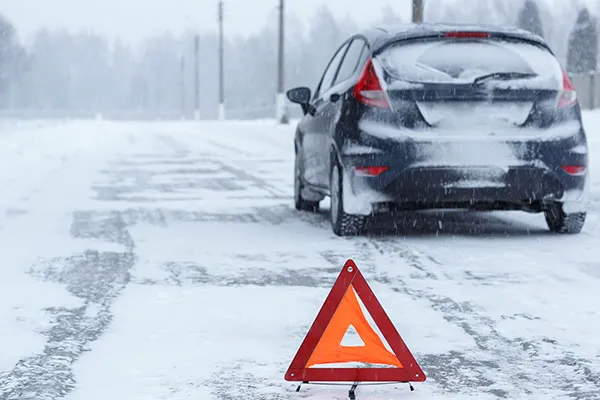


Skidding, a sudden loss of traction between a vehicle's tires and the road surface, is a dangerous situation that can lead to severe accidents. While adverse weather conditions like rain, snow, and ice can increase the risk, the primary cause of skidding is often the driver's behavior behind the wheel. This comprehensive article delves into the role of driving behavior in skidding, explores various road conditions that contribute to the problem, and provides practical techniques for prevention, including proper vehicle maintenance and the utilization of modern safety features.

Skidding occurs when a vehicle's tires lose grip on the road surface. This sudden loss of traction can quickly lead to a loss of control, making skidding one of the most dangerous situations a driver can face. The consequences of skidding accidents can be severe, often resulting in injuries, fatalities, and significant property damage. Moreover, skidding is a contributing factor in many road accidents, particularly in adverse weather conditions.
| Consequence | Description |
|---|---|
| Injuries and Fatalities | Skidding accidents can result in serious injuries or even fatalities due to collisions with other vehicles, pedestrians, or fixed objects. |
| Property Damage | Vehicles involved in a skid may sustain extensive damage, and collisions with other objects or structures can result in costly repairs or replacements. |
Skidding is a contributing factor in a significant number of road accidents, particularly in adverse weather conditions. When drivers fail to adjust their behavior to match the road conditions, the risk of skidding and subsequent accidents increases substantially.
While road conditions can increase the risk of skidding, the primary cause is often the driver's behavior behind the wheel. Excessive speed, harsh braking, and abrupt steering maneuvers can all contribute to a loss of traction and subsequent skidding.
Excessive Speed for Conditions
Driving at excessive speeds for the current road conditions is one of the leading causes of skidding.
Even on a dry, clear day, taking a turn at an excessive speed can cause the tires to lose grip and send the vehicle into a skid.
In wet or icy conditions, the risk of skidding increases exponentially as the tires have less traction on slippery surfaces.
Harsh Braking and Acceleration
Sudden or harsh braking can lead to skidding, especially on wet or icy roads.
When the brakes are applied too forcefully, the wheels can lock up, causing the tires to slide instead of rolling, resulting in a loss of traction and potential skid.
Rapid acceleration can cause the driven wheels to spin, leading to a loss of traction and a potential skid.
Abrupt Steering Maneuvers
Jerking the steering wheel suddenly or making sharp turns at high speeds can contribute to skidding.
This sudden change in direction can cause the tires to lose their grip on the road surface, leading to a loss of control and a potential skid.
While driving behavior is the primary cause of skidding, certain road conditions can increase the risk and exacerbate the problem. Understanding the impact of wet roads, icy conditions, and the importance of proper road maintenance is crucial for preventing skidding incidents.
| Road Condition | Impact on Skidding |
|---|---|
| Wet Roads | When the road surface is covered in water, the tires have less grip, increasing the likelihood of skidding. |
| Icy Conditions | Ice acts as a lubricant, significantly reducing the traction between the tires and the road surface, leading to a higher risk of skidding. |
| Poor Road Maintenance | Well-maintained roads with proper drainage systems and regular de-icing efforts can help mitigate the impact of adverse weather conditions and provide a safer driving environment. |
Proper road maintenance is essential for ensuring optimal traction and minimizing the risk of skidding. Well-maintained roads with proper drainage systems and regular de-icing efforts can help mitigate the impact of adverse weather conditions and provide a safer driving environment.
While road conditions can increase the risk of skidding, drivers can take proactive steps to prevent these dangerous situations by adjusting their driving techniques. Proper techniques include:
Adjusting Speed for Conditions
Reducing speed when driving on wet, snowy, or icy roads is crucial for maintaining control and preventing skids.
Even if the posted speed limit is higher, it is essential to slow down to match the current road conditions and ensure the tires maintain sufficient traction.
Smooth Braking and Acceleration
Applying the brakes and accelerator gradually and smoothly can help prevent skidding.
Sudden or harsh inputs can cause the tires to lose traction, leading to a loss of control.
By maintaining smooth and controlled inputs, drivers can better maintain grip on the road surface.
Gentle Steering Inputs
Making smooth, gradual steering movements, especially when entering turns or changing lanes, is essential for preventing skids.
Abrupt steering can cause the tires to lose grip, potentially leading to a skid.
Gentle inputs allow the tires to maintain traction and provide better control over the vehicle.
Increasing Following Distance
Leaving more space between your vehicle and the one in front, especially in adverse weather conditions, can provide additional reaction time and allow for smoother inputs to avoid skidding.
Increased following distance gives drivers more time to react and adjust their speed or steering inputs as needed.
In addition to adjusting driving behavior, ensuring proper vehicle maintenance can also play a crucial role in preventing skids. Regular maintenance checks and replacements of worn components can improve traction and control on the road.
| Maintenance Item | Importance |
|---|---|
| Tire Tread Depth and Condition | Regularly checking and replacing worn tires is essential for maintaining optimal traction. Tires with sufficient tread depth and good condition can better grip the road surface, reducing the risk of skidding. |
| Proper Tire Pressure | Maintaining proper tire pressure is crucial for optimal traction and control. Underinflated or overinflated tires can reduce grip and increase the likelihood of skidding. |
| Brake System Performance | A well-maintained brake system is crucial for preventing skids. Worn brake pads or other brake system issues can lead to longer stopping distances and increased risk of wheel lockup, both of which can contribute to skidding. |
| Regular Maintenance | Regular vehicle maintenance is essential for ensuring all systems are functioning properly and contributing to optimal traction and control. Neglecting maintenance can lead to worn components, reduced performance, and an increased risk of skidding. |
Regular vehicle maintenance is essential for ensuring all systems are functioning properly and contributing to optimal traction and control. Neglecting maintenance can lead to worn components, reduced performance, and an increased risk of skidding. Following the manufacturer's recommended maintenance schedule can help keep your vehicle in top condition and better prepared to handle various road conditions.
Many newer vehicles are equipped with advanced safety features designed to help prevent or mitigate skidding situations. These features can provide an additional layer of protection and assist drivers in maintaining control.
| Safety Feature | Description |
|---|---|
| Anti-lock Braking Systems (ABS) | ABS prevents wheel lockup during hard braking situations, allowing the wheels to maintain traction and steerability, reducing the risk of skidding. |
| Traction Control Systems | These systems monitor the speed of each wheel and apply braking force or reduce engine power to the spinning wheel(s) to regain traction, preventing skidding caused by excessive wheel spin. |
| Electronic Stability Control (ESC) | ESC monitors the vehicle's direction and intended path, and can automatically apply braking force to individual wheels or reduce engine power to help correct the vehicle's trajectory and prevent skidding or loss of control. |
While these modern safety features can provide valuable assistance, it is important to note that they are not a substitute for safe driving practices. Drivers should still exercise caution, adjust their behavior to match road conditions, and maintain proper vehicle maintenance to maximize the effectiveness of these systems and minimize the risk of skidding accidents.

Continuous driver education and awareness are crucial for promoting safe driving practices and preventing skidding incidents. Understanding the causes of skidding, recognizing potential risk factors, and learning proper techniques for prevention can empower drivers to make informed decisions on the road.
Understanding Skid Causes and Prevention
Driver education programs should focus on teaching the primary causes of skidding, such as excessive speed, harsh braking, and abrupt steering maneuvers.
By understanding these factors, drivers can better recognize situations that may lead to skidding and take appropriate preventive measures.
Defensive Driving Techniques
Defensive driving techniques, such as adjusting speed for conditions, maintaining a safe following distance, and anticipating potential hazards, should be emphasized in driver education programs.
These techniques can help drivers avoid skidding situations and respond appropriately if a skid does occur.
Importance of Continuous Learning
Driving conditions and vehicle technologies are constantly evolving, making continuous learning essential for safe driving.
Drivers should stay up-to-date with the latest information, attend refresher courses, and remain open to learning new techniques and best practices for skid prevention and overall road safety.
Skidding on the road is a serious issue that can have devastating consequences, but it is often preventable through proper driving behavior and vehicle maintenance. By understanding the role of excessive speed, harsh braking, and abrupt steering in causing skids, drivers can take proactive steps to adjust their techniques and reduce the risk. Additionally, maintaining proper vehicle condition, utilizing modern safety features, and continuously educating oneself on skid prevention can further enhance road safety.
Ultimately, prioritizing safe driving practices and taking responsibility for our actions behind the wheel are crucial for creating a safer driving environment for everyone. By following the guidelines outlined in this comprehensive article, drivers can significantly reduce the likelihood of skidding accidents and contribute to a safer driving experience for themselves and others on the road.
Skidding occurs when the tires lose traction with the road surface due to water, ice, or other slippery substances. Excessive speed, harsh braking, and abrupt steering inputs increase the risk of skidding in these conditions.
Regularly checking and replacing worn tires, maintaining correct tire pressure, and ensuring proper brake system performance can improve traction and control, reducing the likelihood of skidding. Well-maintained vehicles are better equipped to handle various road conditions.
ABS prevents wheel lockup during hard braking, allowing the wheels to maintain traction and steerability, reducing the risk of skidding. It helps drivers maintain control in slippery conditions.
Driving at excessive speeds, especially on wet or icy roads, increases the chances of skidding as the tires have less grip on slippery surfaces. Reducing speed is crucial for maintaining control in adverse conditions.
In a rear-wheel skid, drivers should steer in the direction of the skid until regaining traction, then gradually straighten the steering wheel to recover control.
Drivers should apply the brakes smoothly and gradually, avoiding sudden or harsh braking that can cause the wheels to lock up and lead to skidding.
Abrupt or jerky steering inputs can cause the tires to lose grip, potentially leading to a skid. Gentle and gradual steering movements help maintain traction and control.
Increasing the distance between your vehicle and the one in front provides additional reaction time and allows for smoother inputs, reducing the risk of skidding.
Traction control systems monitor wheel spin and apply braking force or reduce engine power to regain traction, helping prevent skidding caused by excessive wheel spin.
Continuous driver education and awareness promote safe driving practices, teach skid causes and prevention techniques, and empower drivers to make informed decisions on the road, reducing skidding incidents.

Sarah isn't your average gearhead. With a double major in Mechanical Engineering and Automotive Technology, she dived straight into the world of car repair. After 15 years of turning wrenches at dealerships and independent shops, Sarah joined MICDOT to share her expertise and passion for making cars run like new. Her in-depth knowledge and knack for explaining complex issues in simple terms make her a valuable asset to our team.







